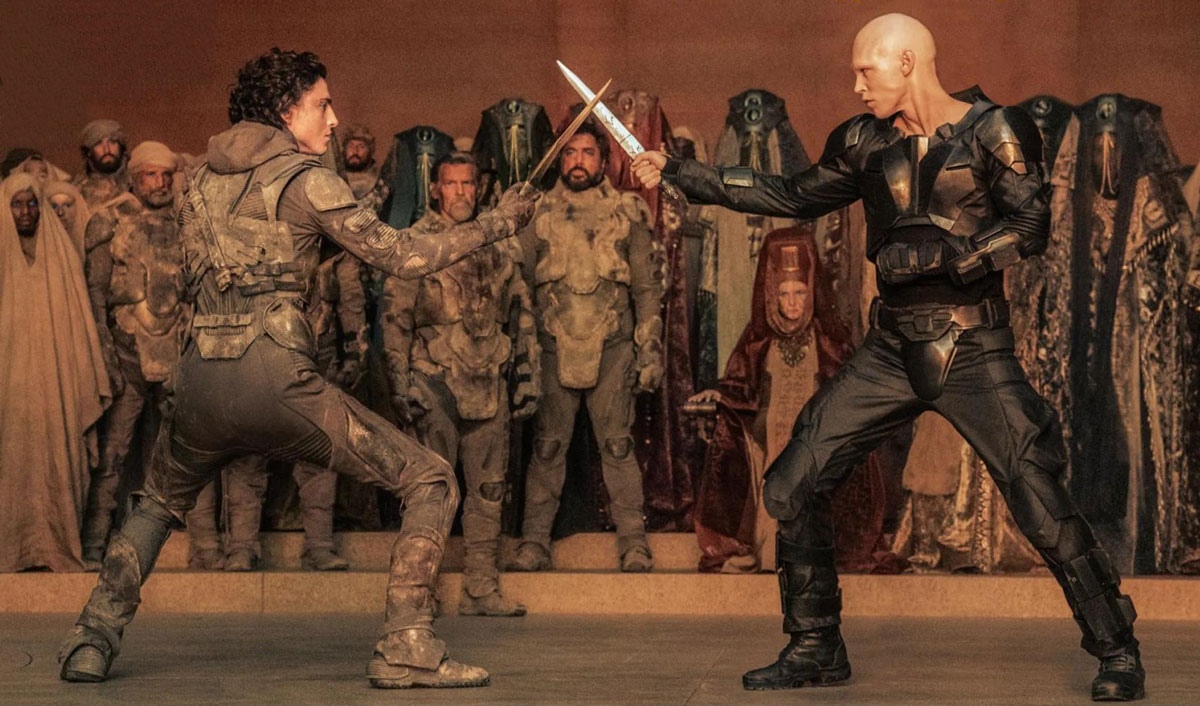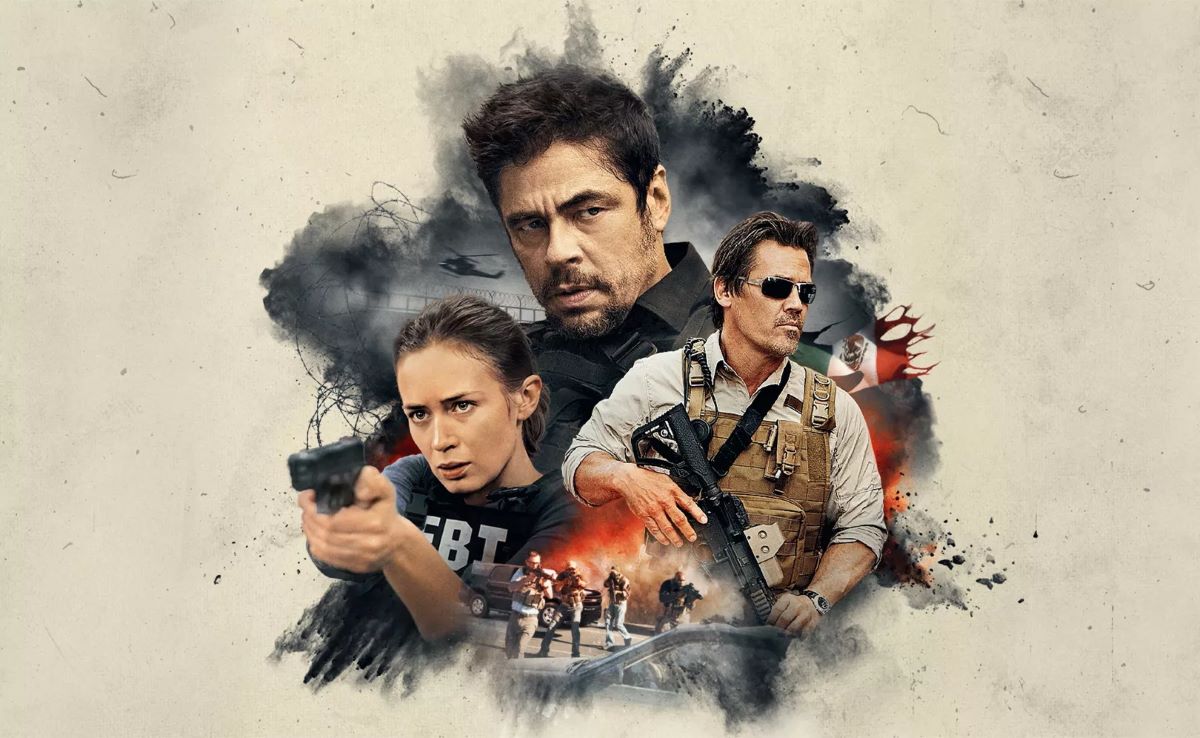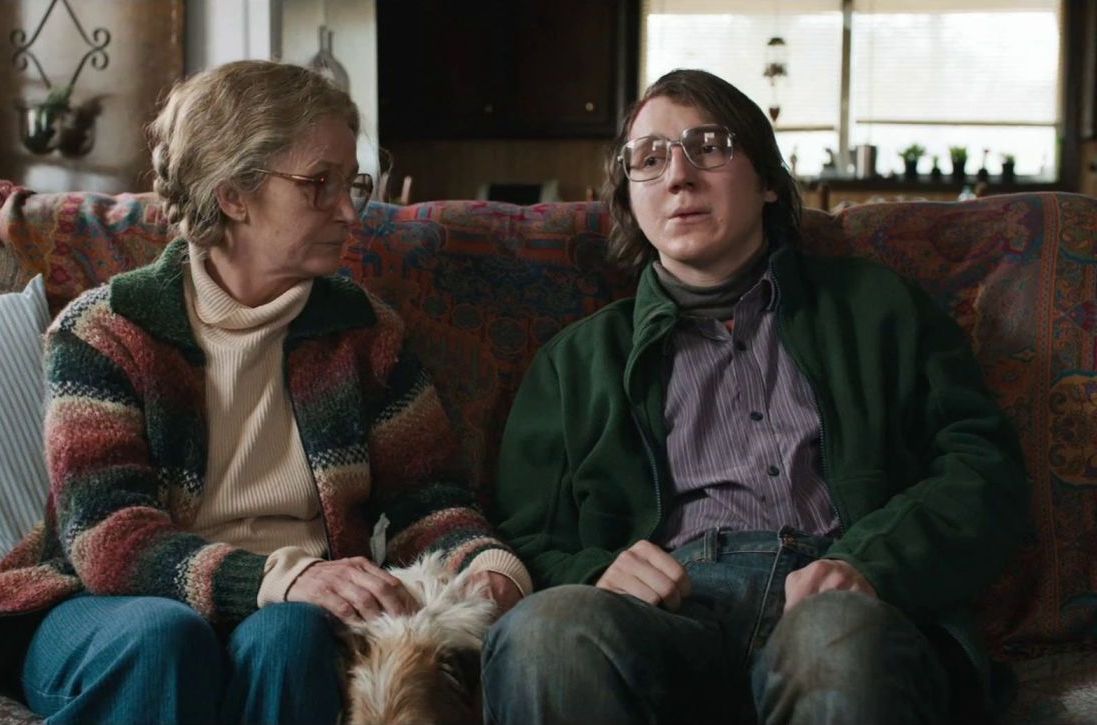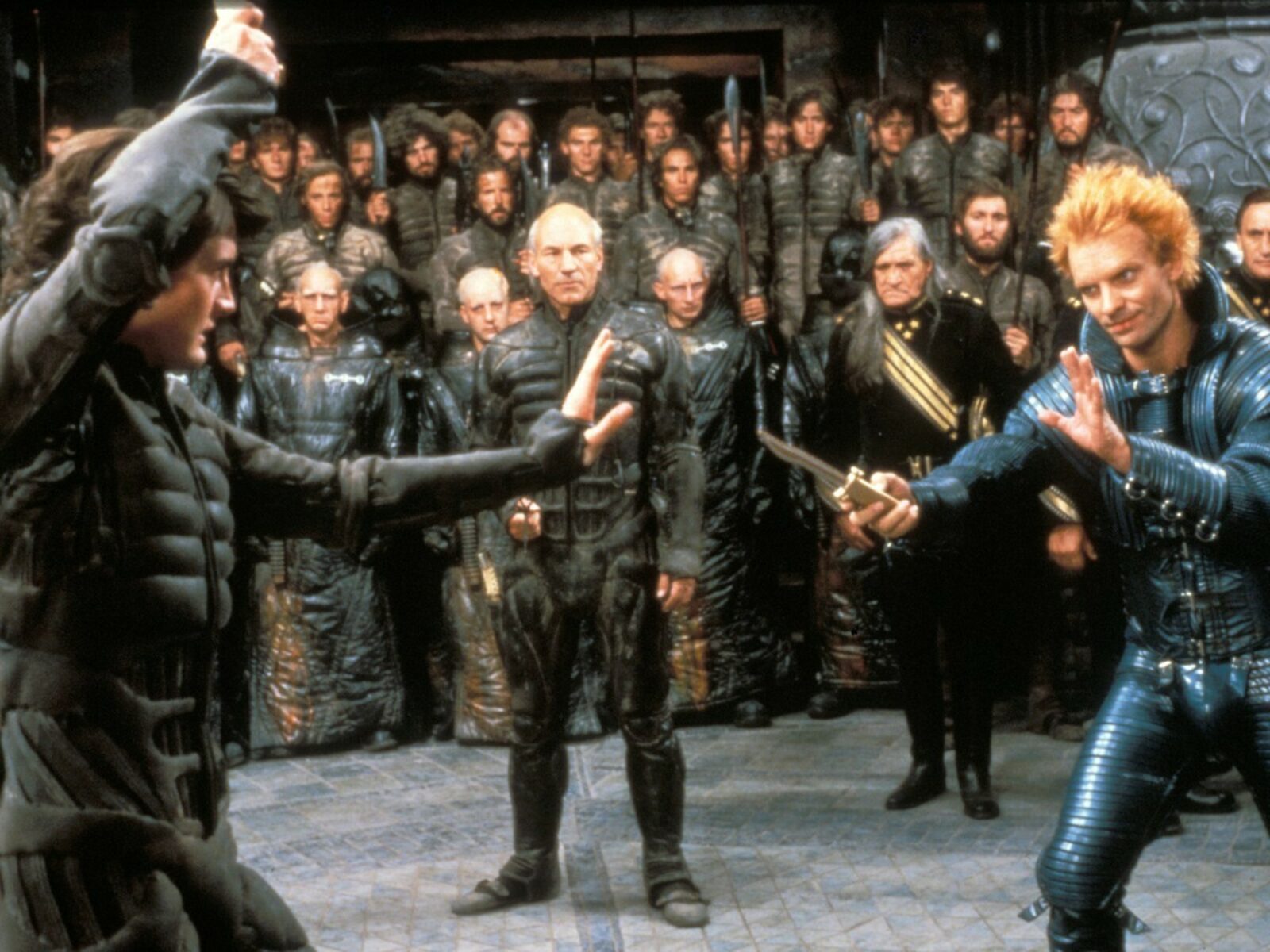As excitement mounts for Dune: Part Two, directed by Denis Villeneuve and featuring Timothée Chalamet, the upcoming film is poised to build on the epic narrative introduced in its first part. This sequel, eagerly awaited by fans, is set to explore further the transformative journey of Paul Atreides into the prophetic Muad’Dib amidst the backdrop of the desert planet Arrakis and its complex socio-political landscape. From the information gathered so far, Dune: Part Two is expected to captivate with its blend of visual splendor, emotional resonance, and a richly layered narrative. It will continue to explore themes of destiny, power, and resistance, focusing on Paul’s acceptance of his role within the Fremen culture and the unfolding war. The sequel aims to provide a deeper insight into character arcs, particularly through the lens of Paul’s internal conflict and his interactions with key characters like his mother Jessica and Chani. The ensemble cast, including Rebecca Ferguson and Zendaya, promises to bring depth and nuance to Frank Herbert’s iconic story, setting the stage for a tale of epic warfare, leadership dilemmas, and the consequences of wielding absolute power, all while emphasizing the significance of human connection and the perils of idolizing charismatic leaders.
Desert Power
Like a colossal sandworm racing towards the rhythmic beat of a thumper, Dune: Part Two is almost upon us. And this time, it’s war. Total Film returns to Arrakis with writer/director Denis Villeneuve and his (inter)stellar cast to spill the spice on the sci-fi event of the year.
The word Muad’Dib has several meanings in the world of Dune. It is both a small, saucer-eared mouse that scurries across the desolate surface of Arrakis, and the chosen Fremen name of Paul Atreides, symbolising his destiny as one wise in the ways of the desert. For Dune director Denis Villeneuve and his star Timothee Chalamet, the word has added significance – ‘Muad’Dib time’ was the message Villeneuve sent Chalamet when Dune: Part Two got the greenlight in October 2021.
‘There were moments over the course of shooting the first film where I was yearning for Paul, after he left Caladan, to not still be in the process of formation,’ Chalamet explains, speaking to Total Film in early January, tousled hair screen-perfect even for a Zoom call. ‘My most common way of expressing that was: “When does Paul become Muad’Dib?” [Denis] would always preach patience. In sending me that text, it was clear that this is the story where we would see Paul come into his own.’
Long-awaited following that agonising cliffhanger and an excruciating, strike-related delay; Dune: Part Two is the concluding instalment of Villeneuve’s breathtakingly tactile rendering of Frank Herbert’s seminal 1965 novel. Part One was a rare genre blockbuster embraced by audiences and typically sniffy awards bodies, cleaning up in the technical categories at the 2022 Oscars by winning best cinematography, editing, sound, visual effects, production design and score.
The decision to split the film in two ultimately proved as wise as the humble Muad’Dib – ask David Lynch who had a paltry 45 minutes to cover the same ground as Dune: Part Two in his critically compromised 1984 adaptation – but it was a risky strategy that meant, until those opening weekend numbers came in, a conclusive sequel was far from guaranteed.
‘When I was shooting [Part One], I remember saying to myself, “If that’s the only movie, I want to be at peace.” So I gave everything,’ Villeneuve recalls during a conversation with Total Film in Madrid, where the life-long fan of Herbert’s novel has just screened the first 12 minutes of Dune: Part Two, and further select scenes, in all their IMAX glory to a mouth-agape TF. ‘Of course, for me, it was not about box office. It was about: do people feel that you have been a traitor [to the novel], or does the world accept your adaptation? I felt that it was a “yes”, and that I was able to go on to make Part Two.’
CULTURE SHOCK
Co-writing the film’s script with returning screenwriter John Spaihts, Villeneuve describes the process of adapting Part Two as ‘more challenging’ than their work on the world-building first instalment because ‘storytelling-wise, it’s more dense’. Much of that complexity can be attributed to the fact that Paul and his Bene Gesserit mother Jessica (Rebecca Ferguson) fully embrace Fremen culture in Part Two, having earned their place among the community of Sietch Tabr, under the leadership of Javier Bardem’s Stilgar. Then there’s the small matter of Paul stepping into his cataclysmic fate as prescient super-being the Kwisatz Haderach, and all that entails for the future of their world.
‘One of things that I’m proudest of is howTimothée Chalamet portrayed Paul, and how he transformed in front of the camera from a teenager into that messianic figure – a tormented young man trying to deal with his destiny,’ says Villeneuve. ‘There are scenes where he has to scream in Fremen in front of hundreds of [supporting artists],’ adds Ferguson. ‘That’s scary. And the resonance with which he does it, and the power with which he does it – it was mesmerising.’
‘It doesn’t make his journey so righteous,’ says Chalamet, who describes the process of playing Paul over four years as a ‘surreally lived-in experience’ having ‘come into his own’ as a person in parallel with the character. ‘That’s what Frank Herbert’s warning really was, in not only Dune, but [sequel novel] Dune Messiah. To be wary of charismatic leaders; to be wary of people that hold too much power. That’s something Paul wrestles with in the second movie, where he’s actively resisting a certain path that calls on him to be a complete leader, because he knows what comes with it.’
The Fremen are initially sceptical of Paul, but many come to believe he is their long-prophesied ‘Lisan al Gaib’ (off-world saviour), including Stilgar. ‘In the beginning, he doesn’t really know if he trusts this new kid. But he wishes he will be The One…’ Bardem tells TF. ‘Something changes, and then there is a blind faith – as with many religions.’ Bardem made an outsized impression as Stilgar in Part One, despite appearing on screen for approximately 12 seconds. It was the promise of Part Two – and a pledge that he’d get to ride a sandworm (‘Denis kept his word,’ Bardem smiles) – that made Villeneuve’s initial offer irresistible.
‘Denis said, “I’m going to offer you a movie that you are not in, but if there is a second one, you will be in it.” I was like, “I’m in!”’ chuckles Bardem, who has a much more significant role to play in Part Two. ‘It was a different game for me. It was a chance to be more immersed in the process, and to develop the character to a beautiful, vulnerable place.’ Stilgar finds he is united in belief with Jessica, ‘two people who are very religious in their way’ according to Ferguson. ‘The moment that she realises Stilgar believes in her son – there’s nothing stronger for her. That sets the bar for their relationship.’
SAND-STRUCK ROMANCE
In contrast to Stilgar and Jessica, Zendaya’s Fremen Chani may believe in Paul as a person, and even come to love him, but she puts no stock in prophecies. ‘In the book Chani meets Paul and is like, “Alright, this is the guy. I support you.” Whereas in our film, in no way does she bend how she feels,’ says Zendaya, who ‘longed’ for more time in the world of Dune after filming for little more than a week on Part One. ‘She’s strong in her convictions. Even when she’s falling in love, she still doesn’t like what [Paul] represents.’
Chalamet describes Chani as Paul’s ‘moral compass’, while according to Villeneuve ‘the core of this film is the love story between Paul Atreides and Chani’, which may account for the director’s claim that Part Two is his most ‘emotional’ movie to date. This star-crossed romance, which is kindled in the magic-hour glow of the deep desert in Abu Dhabi and Jordan – enough to make anyone fall in love – grounds a gargantuan story about worlds at war according to Zendaya. ‘Because it’s so high-stakes you have to go back to something that’s really human, which is love,’ the actor says. ‘It’s something everyone can relate to, and feel connected to.’
Like Stilgar then, Chani’s limited role in Part One will be greatly expanded in Part Two, even beyond the scope of the novel, with Villeneuve claiming that ‘as the movie progresses, there’s a shift in the main character, and Chani becomes my reference as a point of view’. Zendaya notes that ‘what Denis does very well is take the female characters more deeply into consideration’ in a way that was rarely the case for science-fiction in the 60s. ‘He was really able to build out a strong sense of [Chani’s] own views and life. It wasn’t entirely like she’s at the will of who she’s in love with. I did feel a particular sense of care for what Chani represents in his films.’
Jessica similarly benefits from this sense of care. Villeneuve even highlights her increased presence as the single biggest difference between the novel and his adaptation. ‘Strangely, Jessica’s more in the background in the second part [of the novel] – I thought that was not proper,’ he asserts. ‘She’s still Lady Jessica, the main architect of the story. I thought that was a very powerful idea that was not sustained in the book. I made sure that she has the character presence in the second part.’
‘Jessica wants to protect Paul, but constantly has her own agenda,’ Ferguson points out, speaking to TF on a day off from filming the second season of Apple TV+ series Silo. ‘She will go on her own journey to fight and gather strength in a different form.’ As Bardem explains, Jessica becomes a ‘powerful, religious figure in the Fremen world that really is able to manipulate people’s beliefs’ after undertaking a dangerous ritual involving the Waters of Life. ‘That’s one of my favourite scenes [in the film],’ Ferguson smiles. ‘For Jessica, no decision is made without understanding the harsh – sometimes lethal – consequences of that choice. But she’s forced to try to take control back.’
There’s also Jessica’s pregnancy to consider, which has paradigm-shifting consequences in the world of Dune. It’s the only topic Villeneuve won’t go near today (‘I need to keep some mystery,’ he says with a smile), but Ferguson offers a cryptic tease: ‘Having a Bene Gesserit pregnant, we can say, is not like me being pregnant. It’s a whole other journey.’
FRIENDS REUNITED
Of the other major surviving members of House Atreides, invaluable Mentat Thufir Hawat (Stephen McKinley Henderson) becomes an unwilling servant of the Baron (Stellan Skarsgard), while revenge against the Harkonnen is front of mind for Gurney Halleck 0osh Brolin) once he’s reunited with Paul. ‘It’s very personal to him,’ says Brolin, who turned to the novel to inform Halleck’s backstory. ‘But he doesn’t think he’s in a position where he can enact revenge until that surprise happens, and he can get back on a trajectory that he’s very comfortable with.’
Brolin got to fulfil two years-in-the-making dreams on Dune: Part Two – a proper scene with Javier Bardem (‘Denis wrote a scene of dialogue for us, because we both said, “On No Country for Old Men, we didn’t share the screen. Give us a scene!’” . Bardem chuckles), while Gurney will finally break out the nine-stringed baliset after a performance filmed for Part One was left on the cutting room floor. ‘Tonally, he was right [to cut] the first one,’ Brolin nods. ‘This one, the placement is right. I wrote the lyrics, and Hans [Zimmer] wrote the music. I didn’t think the scene would turn out as well as it did, but I’m really happy with it.’
Brolin has nothing but praise for the film after a recent screening, in particular the ‘great new blood that enlivened what may have turned out to be like going back to Season 2 of a series’. Chief among the new additions is Austin Butler, who drops all hints of that lived-in Elvis performance and dons an impressive bald cap, as Feyd-Rautha – a psychotic Harkonnen killer, and favoured nephew of the Baron.
‘Feyd is a mirror of Paul. He’s a perfect nemesis,’ teases Villeneuve, who cast Butler in spring 2022 after Baz Luhrmann gave him a sneak peek at his star-making turn as the King of Rock and Roll. ‘I was mesmerised by his charisma. I was seduced. It was,
in some ways, a gamble. But when we did the make-up test and the first day of shooting, I was moved to tears by what he brought to the screen. I was like, “Oh my god, it’s 10 times better than I was expecting.’”
With all due respect to Skarsgård and Dave Bautista, who returns as blunt instrument Glossu ‘The Beast’ Rabban, the Harkonnens don’t exactly trade on their good looks, but Feyd-Rautha has a dangerous allure that makes him the ‘rock star of the family’ according to Villeneuve. ‘He’s the beautiful Baron nephew. A playboy. A very sexy, charismatic, psychotic killer,’ Villeneuve grins. ‘There’s something erotic about it. Everybody needs to be moved by his beauty. And Austin was perfect for that.’ Rautha himself is seduced by Lea Seydoux’s newcomer Lady Margot who, like any good Bene Gesserit, has her own plans within plans (‘It was amazing to see her in full power,’ smiles Butler), and is dispatched by Christopher Walken’s ruthless Padishah Emperor Shaddam IV, and his scheming daughter Princess Irulan (Florence Pugh), to stop Paul before he can become a threat to the Golden Lion Throne. Rautha is also heir apparent to House Harkonnen following the Baron’s near-fatal encounter with Duke Leto in Part One.
‘He’s weakened by the poisoning, and knows that he has to find a replacement,’ says Skarsgard, who’s far cheerier in person than his on-screen counterpart. ‘The Baron, he almost falls in love with Feyd-Rautha. He’s a wonderful killer. He adores him, in a way. But, of course, if he would get out of line, he wouldn’t hesitate to kill him…’ As with the first film Skarsgård spent hours in the make-up chair every morning to become the bulging Baron, a gruelling process for any actor. ‘Of course, I really didn’t want to put on that shit again. It really hurt!’ the actor chuckles. ‘But, in a way, it’s worth it.’ One silver lining this time: no nude scenes. ‘The nakedness means two more hours in the chair. It cut it down to six hours for me.’
Studying Skarsgård’s performance as the Baron in order to locate Feyd-Rautha’s feral voice, Butler imagined the influence he must have exuded over Rautha in youth. ‘There’s a sense of growing up with the Baron, and seeing his power, and being envious of his power,’ Butler explains. ‘I mean that in the Shakespearean sense of when you may love somebody, but may want to kill them at the same time, and take the power. But you have to do that in a wise way, because otherwise it will be taken from you. The constant Machiavellian back-and-forth is definitely a part of their relationship.’
FIGHT CLUB
Butler’s introduction to Dune was a testing one for the actor, in which Rautha fights captured Atreides soldiers in a gladiatorial arena – the Harkonnen idea of a birthday celebration, no less -on his homeworld of Giedi Prime. Villeneuve had a clear vision for the polluted planet from the script writing stage, one which ties neatly into Dune’s broader ecological themes. ‘Giedi Prime is an industrial world,’ Villeneuve explains. ‘I loved the idea that in different worlds, the laws of physics could be different. Maybe there are some stars in the universe where the light doesn’t reveal colours; it’s the opposite, it kills colours. I thought a black-and-white world would fit with their primitive mentality.’
Rather than simply desaturating the image in post, an otherworldly effect was achieved by strapping infrared lenses to the large-format cameras. ‘It wasn’t something that was done in VFX; it was done as we were shooting,’ notes Villeneuve, who captured 100% of Part Two in the expanded IMAX 1.43:1 aspect ratio, as opposed to just ‘35-40%’ of Part One. ‘I explained to the studio that: “We shoot it this way, and there’s no way we can go back.” They signed with their blood [laughs]. But it created a very powerful, eerie feeling that I love.’
‘I was able to see playback of the infrared [as we were filming],’ Butler recalls. ‘I’d never seen anything like that before. It makes your eyes look like a shark. It’s wild.’ The result is undeniably striking, but the filming of the arena scene was challenging in other ways. ‘That was the first sequence filmed for Dune: Part Two,’ Butler notes. ‘It was extremely hot in Budapest at that time – 110°F. We were filming in what was basically a grey box with 200ft walls and sand. So it created a microwave, essentially. There were people who passed out from heat stroke. But I was so grateful to start with that sequence because it was physical. You’re not in your head. I was able to prepare for six months for that, and then go out there, and fight for a week-and-a-half.’
This combat-heavy start to the production set the tempo for what Villeneuve says is ‘more of an action film’ and a ‘more muscular’ movie compared to the ‘meditative and contemplative’ opening instalment. ‘The way I think about it is, Part One was like tossing the ball in the air, and this one’s the baseball bat coming through and cracking it,’ Chalamet says with a grin. For Zendaya, it was an opportunity to get her hands dirty after years of eagerly observing from the sidelines. ‘I’ve watched through many-a-Spider-Man how much effort goes into creating these sequences,’ the actor points out. ‘I was like, “Damn, I want to get out there, and kick some butt!” The trailers tease warfare on a planetary scale, with Fremen shooting down ornithopters from atop sandworms. ‘When you see the battles here you go, “I haven’t seen that before.” It’s crazy,’ says an animated Bardem.
What sets the action in Dune apart from most blockbuster tentpoles (other than, you know, sandworms) is that every ‘big set-piece has real lived-in stakes behind it’ according to Chalamet. The perfect example is Paul’s first worm-ride, which is brought to the screen in jaw-droppingly visceral fashion in Dune: Part Two. The outrageously dangerous ritual is a rite of passage among the Fremen, and a turning point in Paul’s journey. ‘Beyond being an exciting sequence in the movie, it represents a coming of age,’ says Chalamet. ‘It’s where Paul’s supposed prophecy would fall flat, and it would mean his death if he can’t rise to the occasion. So the stakes of that moment are huge, and the doing of it was thrilling. It was industrial fans blowing sand, and a slab of worm was built. It was an amazing experience.’
Envisioning exactly how a human is supposed to mount a skyscraper-sized beast in the open desert was one of the first problems Villeneuve tackled on Part Two. ‘When you read the book your brain is connecting the dots, but what’s the technique?’ the director asks. ‘I needed to show the logic of how to ride a worm, and the danger. But, at the same time, Paul needs to be good! To create that fine balance is fun because, as a filmmaker, I never had the chance to show the birth of a hero.’
Worm-riding is far from the only test Paul will face in Dune: Part Two, there’s also Feyd-Rautha waiting at the end of a long and dangerous road for a trailer-teased crucial mano a mano fight. ‘That was definitely one of those sequences that we gave a ton of attention to,’ Butler says. ‘Our lives are in the other’s hands, in a way – we did a lot of work together.’
‘We started kali fight training independently in Los Angeles,’ Chalamet adds. ‘We went after it, man. We were super-motivated. It was inspiring [working with Austin]: how lasered-in he was, and how dark his character was. It really brought purpose to the mission that Paul goes on. That the universe is in better hands with him than with Feyd-Rautha.’
For their showdown, Paul and Rautha have one hell of an audience, with practically the entire top-billed cast of the film assembling in one huge room for the two-or-so weeks it took to shoot, even though many A-listers and legends were required to do little more than watch from the sidelines. ‘That was really quite an exciting room to be in. Anywhere you looked, there was an unbelievable actor,’ says Pugh, who Villeneuve cautions has limited screen time in Part Two, but would have a much larger role to play in any potential sequel. ‘The immediate inspiration there is that everyone has shown up to tell this story,’ adds Chalamet. ‘And everyone is 100% prepared and committed to building the world of Dune for Denis Villeneuve.’
MUSIC MAESTRO
That commitment extended behind the camera to the heads of department, almost all of whom return for Part Two following their fêted work on the first film, including cinematographer Greig Fraser, costume designer Jacqueline West, production visual effects supervisor Paul Lambert, editor Joe Walker and production designer Patrice Vermette, whose sets are described with enthusiastic reverence by the entire cast. ‘These massive spaces are so mind-blowingly constructed… it really inspires a feeling of awe,’ says Butler.
But few went as far as composer Hans Zimmer. Much like Villeneuve, Zimmer is a life-long fan of the book, and basically never stopped working after the first film was completed, writing 90 minutes of brand new music simply to get Villeneuve in the mood for writing Part Two’s screenplay. ‘I remember at one point, he called me, and said, “Denis, listen to this. You’re going to love this,” ’ Villeneuve recalls. ‘I said, “Hans, it’s absolutely fantastic music. I deeply love it. But we released the film six months ago!” He was still scoring non-stop. And he’s doing the same right now, by the way. It’s by far the best score I’ve had in my life, and in Part Two the score is even stronger than Part One. I can say that with confidence.’
There’s a reasonable chance that Zimmer is still writing Dune music as you read this, months after Villeneuve locked picture on Part Two, perhaps to get the filmmaker in the mood for writing Part Three – an adaptation of sequel novel Dune Messiah. Once again, nothing is promised, begging the question: will Villeneuve be ‘at peace’ if Part Two is the end of his time on Arrakis? ‘I will say that there’s something that’s complete, that all of the elements are there,’ Villeneuve nods. ‘But I think the movie adaptation is more tragic than the book. There’s something more heartbreaking. The way that Part Two ends… it would create a total balance and equilibrium to finish Paul’s storyline in what we could say in Part Three.’
If the cast have discussed a third film with Villeneuve, they’re keeping quiet for now. ‘Denis is an artist, and doesn’t like to share things until he’s got it figured out. So whenever he’s ready, we’re all keenly ready to hear what his vision is,’ says Zendaya. ‘The idea excites me very much,’ adds Chalamet, who has yet to receive the crucial greenlight text from Villeneuve. ‘If the time and opportunity comes to complete the story with Messiah, I think we’re all super-enthusiastic about that.’
JORDAN FARLEY
DUNE: PART TWO OPENS IN CINEMAS ON MARCH 1, 2024.
Total Film, February 2024




